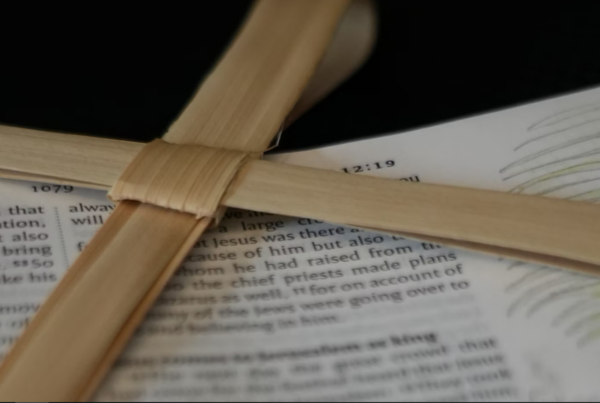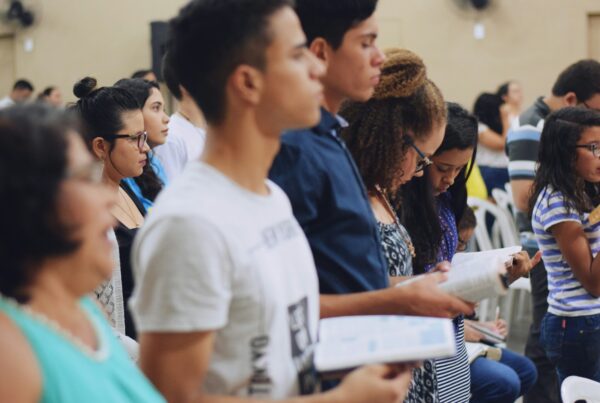Our culture is changing at a faster pace than ever before, and what people need from the church has changed with it. Yet the pace of change within the church has stayed about the same: slow. As a result, Fuller Theological Seminary professor Scott Cormode says “the church as we know it is calibrated for a world that no longer exists.” Cormode believes faithful innovation holds the key to church revitalization.
Scott Cormode has coached hundreds of churches across North America on faithful innovation. We interviewed him about the role innovation plays in church revitalization and what steps you can take to revitalize your church through innovation.
Watch our interview with Scott Cormode:
Scott Cormode on How to Innovate Faithfully
This interview has been lightly edited and condensed for clarity.
What can we learn about innovation from how it works in secular contexts?
Cormode: We’ve always thought people who are innovative think outside the box. It turns out that’s not how scholars think about it. The people who are innovative are usually people who can think in two boxes or more at the same time. The best innovations come from taking something that has worked in a completely different setting and adjusting it to a new setting.
We all have a little house of things that we know—the things that we’re good at. We think the best way for us to innovate is to look for ever-smaller things in the house we already know. Scholars will tell us the best way to innovate is to expand the possibilities. So go look in the backyard. Now go look in the detached garage. What happens if you go and talk to your neighbors? If you’re stuck in your little house, there’s only so many things that you can learn. But if you start listening to things around you, they’re going to spark you to think, wait a second, I can take that thing that works over there and adjust it to work over here.
As Christians, we are committed to an unchanging gospel. How do we both embrace innovation and stay rooted in a gospel that doesn’t change?
If the church as we know it is calibrated for a world that no longer exists, we’re going to have to recalibrate. Now, if I had to recalibrate my watch, what would I do? I’d pull out my cell phone, and I’d find out what time the cell says it is and I’d readjust it. You adjust to a standard.
The tricky part for us is we’re going to have to adjust to two standards at once: the never-changing gospel and our ever-changing people.
In order to be able to adjust to our ever-changing people, we have to get much better at listening. Not just listening to the things that people will tell us, but listening to the things that are behind that—to be able to ask the questions that get at what I would call the longings and losses of the people entrusted to our care. What are the things that, when they sit at the dinner table, they think about? Or more importantly, when they lay in bed at night and they can’t go to sleep? The things that they think about are the things that they long for and the things that are sad, the losses in their lives. If we knew in the church those things, it would change our preaching and teaching agenda.
How do we stay connected to the never-changing gospel? One of the ways to do that is by emphasizing Christian practices. There are certain practices that we have been engaged in as a Christian people for thousands of years. And they’re not just things we happen to do. They are things that scholars would argue constitute the gospel.
No one would say, “Oh yes, there have been churches that sometimes that have worshiped God, and there’ve been other churches that chose not to worship God.” There are no such things as churches that never gave alms to the poor. There’s no such things as churches that never practiced hospitality for strangers in their midst. That has been part of the standard ever since we started reading the Old Testament. We can work on reinventing Christian practices, thinking of ways that we can update them for current life.
Can you give an example of faithful innovation within a church?
Let me give you an example of an Anglican church in Florida. The youth minister had a whole bunch of middle schoolers. She didn’t really have any high schoolers in her group, and almost all the middle schoolers were people who were not children of the congregation.
The youth minister spent time listening to them, and she said, “As I listened to their longings and losses, the number one thing that stands out for me is the losses, the pain, the different things that they’re struggling with.”
In case any of us have never picked it up, being in middle school is painful.
So the youth pastor came to us and said, “I want to work on reinvented practices that would allow us to respond to middle school pain.” And so what we worked on was the practice of lament, a biblical practice of lament.
About half of the psalms are psalms of lament. The way you can find them is, you open your Bible, and you stick your finger in it. If you stick your finger in, you’re probably in a psalm. If you’re probably in a psalm, you’re probably in a psalm of lament. How do you know what those are? Those are the ones that no one ever reads in your church. They’re the ones that people cry out to God with pain. And the thing that they cry out is, “Why God?” Why? Why?”
The message of the psalms of lament is that God can handle your honesty—even and especially if you’re angry at God. And so one of the things that she was teaching these middle schoolers is that God can handle your honesty. God’s not going anywhere. We can handle your honesty. We’re not going anywhere.
We did a whole bunch of work with her to develop how to get middle schoolers doing lament. She went back to her parish. They did a ten-week project. Halfway through the ten-week project, the parents come up to the youth minister and say, “We want in.”
Now remember, these are not children of the congregation. And the parents say, “Whatever you’re doing, I want in.” And so they had this parents’ night. They talked about lament. The parents were all in.
Word gets out. Pretty soon the congregation comes and says, “We want in.”
The following Lent, the Lenten season in that congregation was focused on lament. The middle schoolers led it in the worship service. It was beautiful because it was something that was deeply part of our Christian tradition. I mean, there is nothing more deep to us than the Psalms. Reinventing how they saw the Psalms allowed the church to see middle school differently, which allowed them to see middle schoolers differently, which allowed them to see themselves differently, which allowed them to see God differently. That’s how innovation should be.
How does the Fuller Theological Seminary Innovation Project help churches navigate faithful innovation?
First we take them through a five- or six-week online training for a team of three or four people. We teach them how to listen. And then we send them out to do some listening projects.
Then we gather together what’s called an innovation summit, where your team is brought together with up to eight to ten other congregations. We take them through a process that is built around three things: Christian discernment, the intricacies of practical theology, which is a well-established Christian discipline, and what’s called human-centered design. (It’s how Silicon Valley does its innovation.) At the end of the summit, each team has a prototype of something they want to do.
The third piece of the process is a ten-week rollout, where they try this prototype as an experiment at home with a coach.
As you’ve worked with churches on innovation, have any particular approaches to innovation proven especially effective for church revitalization?
The number one thing that we teach churches to do is how to listen and what to listen for.
If you develop a constructed habit of listening, it will change every conversation that you have. We think of ourselves as having stock answers to well-known questions. As someone will be talking, you think, in the back of your head, Oh, this is answer 17b. I’ll give you answer 17b, and everything will be well.
We train people to accumulate enough answers to all the stock questions. The problem is that those aren’t the questions people are asking anymore. Or they are still asked, but the answers that we learned were created for a version of those questions that doesn’t exist anymore.
We have to listen to people long enough that we can take what is answer 17b, and translate it into contemporary life. And that only happens if we have listened so well that we are responding to exactly what we’re hearing in the moment.
What practices can we adopt to be better at listening?
At the church in Florida they decided to do empathy training. As part of the empathy training, they told people, whenever you’re going to spend some time listening to somebody, bring something to drink. Every time that you have the urge to say, “yeah, but,” or to interrupt, or to do something that makes you stop listening, take a drink. That’s just a way of saying, listen a little longer.
At Fuller Youth Institute, we teach people that the best response to anybody saying something difficult is to say this: “I’m so glad you told me. Tell me more.” If you just say, “Tell me more,” it can sound a little bit like you’re cross-examining them, but “I’m so glad you told me” is a welcoming statement. Oftentimes you go three, four, five times around with that before you get to the point where somebody is really able to tell you what they wanted to say.
In the medical world, they teach you about what they call the “doorknob conversation.” So say you’re a doctor who has had a patient meet with you. You’re all done, you’re writing up your notes, the patient is walking out the door, their hand is on the doorknob, and they say, “One more thing.” In all of our minds, we’ve moved on. We’re ready to have the patient be gone. Almost always that “one more thing” is the reason the person came.
Are there any myths about innovation that you want to set the record straight on?
My grandmother had a tiny little house, not that much bigger than this room. But she had in that house in the backyard a redwood tree, like a sequoia.
In the 1920s, when a guy named Lester owned the place, he went to visit the sequoias, and he saw a little sapling. And so he dug around it, and he put it in a coffee can, and he took it home with him. (That’s not legal; don’t try this at home. But this was the 1920s.) He planted it in his backyard. And he watered it, and he nurtured it. It struggled and it struggled and it struggled, but eventually, it hit the water table, and it took off. And now it is the tallest tree in the valley.
That is the image we have of innovation. One person discovers the struggling idea and nurtures it. Finally something happens after years of work, and then it takes off and it becomes this big, giant thing.
That is a myth built around myths.
Number one is the idea of the lone inventor. Almost everybody who’s anybody in innovation works as a team. It’s not a lone person.
Number two is, if you wanted to get a tall tree, the best way to do that is not to plant one sapling and to nurture it. It’s to plant a zillion saplings and nurture all of them. And then when you find the ones that are really growing, you nurture them, and then they take off.
In innovation, 19 mediocre ideas are better than one good one. You don’t know which one’s going to become the sapling that takes off. If you look at the history of what we can now consider to be obviously good ideas, they were not obviously good at the beginning. They were just mediocre ideas that people were practicing, and trying, and then over time they got better with.
Some people might find pursuing 19 different ideas overwhelming. How do you pursue multiple ideas at once with limited time and resources?
Always try your experiments on the margins. The last thing you want to do is pick the worship service as a place to try an idea because that’s the least forgiving place (ironically) in a church. A worship service is like a treaty between all these different interest groups, and everybody’s got their thing. You don’t want to sign up to make your rookie mistakes in public. And everybody makes rookie mistakes.
So find lots of places to try one new idea a week. The ones that go poorly, you learn from. The ones that go well, you keep nurturing.
Right now, every time somebody tries something new, it feels like a big thing. You know, we have an announcement and logo and theme music. It’s like saying, “Let’s invite everybody to rehearsals and let them see the first time we ever read through the play before we actually put it on.” And then it looks like we have never practiced. Well, it’s because we never have! Instead of one big idea that you spend all this angst about, develop a habit of trying new things over and over again.
Grace Ruiter co-founded Faithward and oversaw its growth from a small blog to a ministry that reaches 100,000-200,000+ people each month. She has been asking too many questions ever since she started talking, and she has no plans of stopping now. Although her curiosity has challenged her faith at times, it's also how her relationship with God has grown to where it is today. You can get in touch with Grace at graceruiterwrites@gmail.com.




